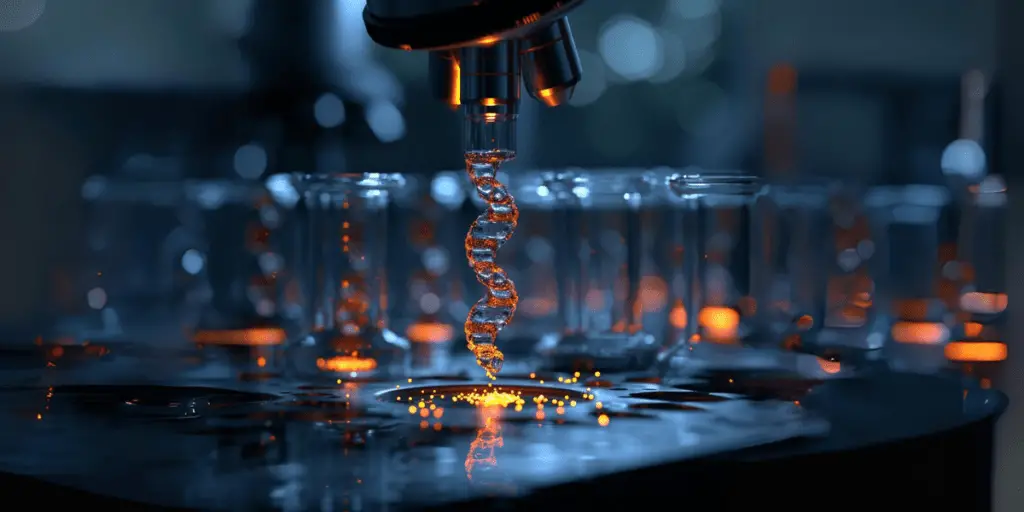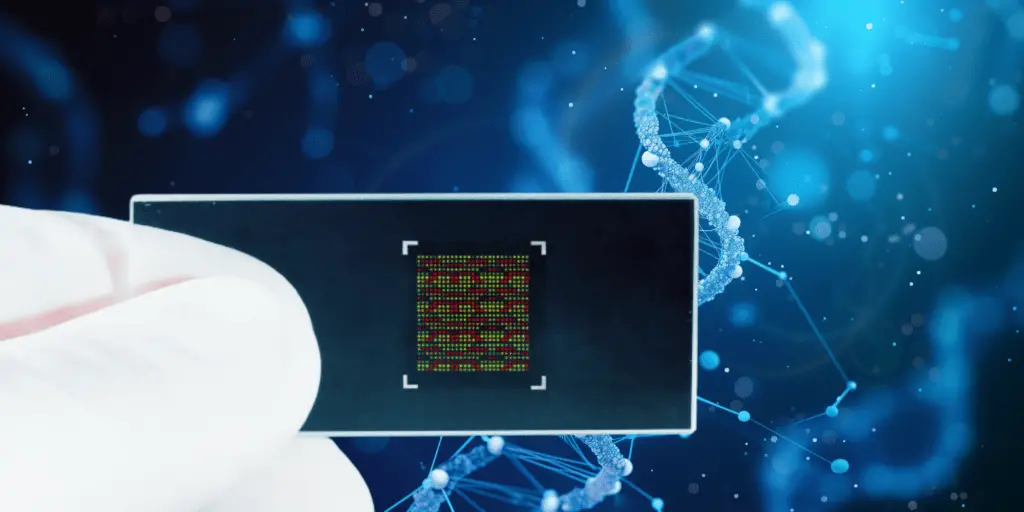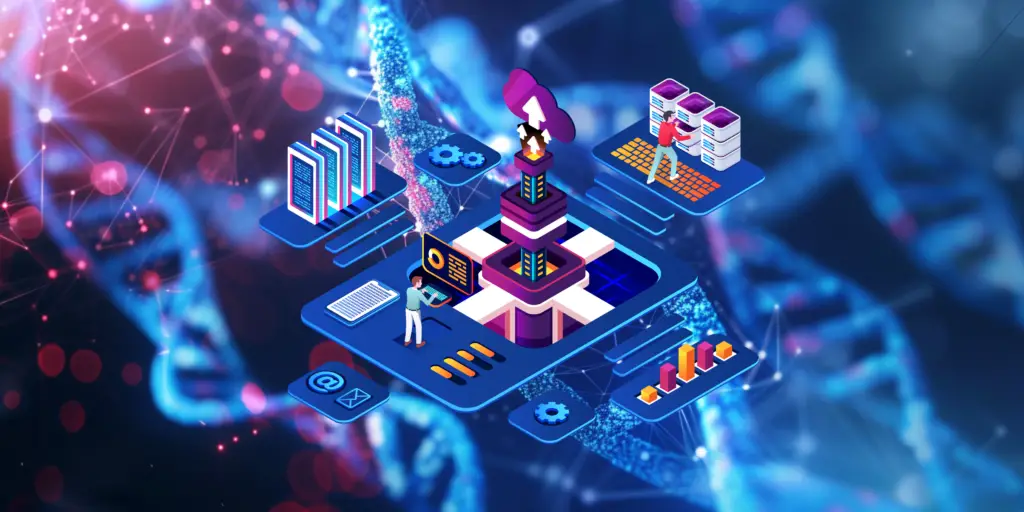Ever-evolving landscape of technology, a groundbreaking development has emerged from the collaborative efforts of engineers at the Rochester Institute of Technology and the University of Minnesota.
These researchers have introduced a novel method for processing data stored in DNA, marking a significant leap toward the future of highly efficient and robust “biocomputers.” This innovative approach hinges on the development of a “microfluidic integrated circuit,” designed to execute operations through artificial neural network computations on DNA-stored data.
The initiative not only addresses the burgeoning need for sustainable data storage solutions but also opens up a new realm of possibilities for computational technology.
As we stand on the cusp of a new era where biology and computing converge, this development promises to redefine our approach to data storage, offering a glimpse into a future where information could be stored and processed within the fabric of life itself.
DNA-Based Computing
The advancements in DNA-based computing represent a pivotal shift in our approach to data storage and processing. At the heart of this innovation are the efforts of engineers at the Rochester Institute of Technology and the University of Minnesota, who have developed a “microfluidic integrated circuit.”
This technology is not just an incremental improvement over existing data storage methods; it’s a radical reimagining of how we can harness the intrinsic properties of it to perform complex computations.
The core innovation, the microfluidic integrated circuit, is designed to perform operations through artificial neural network computations directly on data stored . This approach leverages the compact and dense nature of DNA to store vast amounts of data in a minuscule physical space.
The circuit itself operates by manipulating tiny volumes of fluids to process data stored in DNA sequences, effectively turning biological molecules into computing elements.
It solely as storage medium to a vehicle for computation represents a significant technological advance. Researchers have long recognized it’s potential for storing information, given its ability to pack data in a highly compact form.
The idea of using DNA not just to store data but to process it introduces a new paradigm in computing. By encoding data into DNA, this method allows for operations like addition, multiplication, and other nonlinear functions necessary for neural network computations to be performed directly within the it’s strands.
One of the driving motivations behind the development of DNA-based computing is the quest for sustainability.
The traditional data centers that power today’s digital world require vast amounts of energy, posing significant environmental challenges. DNA-based computing, on the other hand, offers a path to dramatically more energy-efficient processing and storage solutions.
The researchers at RIT and the University of Minnesota are not just aiming to create a new form of computing; they’re looking to redefine the infrastructure of data processing in a way that’s sustainable for the planet.

DNA as a Storage Medium
The exploration of DNA as a medium for data storage has uncovered a wealth of benefits that significantly surpass the capabilities of traditional storage media.
The intrinsic properties of DNA—its compactness, durability, and efficiency—offer unparalleled advantages for data storage that could redefine the future of information technology.
DNA boasts an extraordinary storage density, estimated to be at least 1,000 times denser than the most compact solid-state hard drives available today. This remarkable density means that a single gram of DNA can store approximately 215 petabytes of data.
This level of compactness presents a solution to the escalating demand for data storage in an increasingly digital world. When it comes to longevity, it’s storage offers unmatched advantages. It is at least 300 times more durable than the most stable magnetic tapes, with the potential to preserve data for centuries or even millennia under the right conditions.
This durability stems from a biological design to carry genetic information through generations, making it an ideal medium for long-term archival storage.
Unlike conventional storage media that require constant energy to maintain data integrity, DNA storage is inherently stable and does not necessitate ongoing maintenance. Once data is encoded into DNA, it can remain intact without the need for power or active cooling, offering a sustainable alternative to energy-intensive data centers.
The process of copying files stored in DNA is efficient. It incurs a negligible cost, especially when compared to the energy and resources needed to duplicate data on traditional media.
This aspect of it’s storage could revolutionize how data is replicated and distributed, significantly reducing the economic barriers to large-scale data dissemination. It also offers better data compression than traditional digital methods, enabling more information to be stored in a smaller space.
Coupled with its lower energetic cost for storage and retrieval, DNA presents an economically viable solution for the massive amounts of data generated and consumed by modern society.
Beyond its core benefits, DNA storage opens the door to innovative applications in fields such as genomics, biotechnology, and beyond.
Its ability to store vast amounts of data in a compact form factor makes it particularly suited for applications requiring high-density, long-term storage, such as archival of historical records, scientific data, and cultural heritage preservation.

The Microfluidic Integrated Circuit
The microfluidic integrated circuit stands at the forefront of the technological breakthroughs enabling DNA-based computing. This innovative device melds the principles of microfluidics—the manipulation of fluids at the microscale—with the vast storage potential of DNA.
Creating a system capable of both storing and processing data in an entirely new way. This section delves into how the microfluidic integrated circuit functions and its significance in the advancement of DNA computing.
The microfluidic integrated circuit utilizes small channels, often only micrometers in size, to manipulate solutions containing DNA molecules. These channels are designed to perform specific functions, such as separating, detecting, and attracting molecules, thereby allowing for the precise control of biochemical processes at the microscale.
Embedded within these channels are nanotech sensors, which play a critical role in the system’s dual functionality: they not only detect specific molecular interactions but also contribute to the processing of data encoded in DNA sequences.
This circuit effectively functions as both a sensor and a computational device. By leveraging the unique properties of DNA molecules to represent and manipulate data, it can perform a variety of operations necessary for neural network computations, such as addition, multiplication, and other nonlinear functions.
The microfluidic integrated circuit represents a significant leap toward bridging the gap between biological systems and digital computing. By using it as a medium for computation, it taps into the natural efficiency and compactness of biological information storage.
While also introducing the capability to perform complex computations within the same system. This dual functionality makes the system particularly suited for applications in biomedical research, forensic science, and environmental monitoring, where it can analyse and interpret biological data in situ.
Incorporating artificial neural network computations into the microfluidic system further amplifies its potential. Neural networks, inspired by the human brain’s architecture, are capable of learning and making decisions.
By integrating these with DNA-based computing, the microfluidic integrated circuit can process data in a way that mimics biological intelligence, albeit on a much smaller scale. This capability could lead to the development of highly efficient, adaptable computing systems capable of solving complex problems in innovative ways.
The development of the microfluidic integrated circuit is a key step towards realizing the full potential of DNA as a platform for both data storage and computation.
As this technology matures, it could lead to the creation of biocomputers that are more compact and efficient than their silicon-based counterparts but also capable of operating in environments where traditional electronics would fail.
The intersection of microfluidics and DNA computing opens up new avenues for research and development, potentially leading to breakthroughs in synthetic biology, nanotechnology, and materials science.
The ability to manipulate biological molecules and processes with such precision could revolutionize our approach to healthcare, environmental monitoring, and the very nature of computing itself.

Applications
The advent of DNA-based storage and computing heralds a transformative shift in the landscape of data management and processing, offering solutions that transcend the limitations of traditional digital technologies.
With the unique advantages of DNA—including unparalleled storage density, exceptional durability, and the potential for low-energy, sustainable operations—this novel technology is poised to revolutionize a variety of fields.
One of the most compelling applications of DNA-based storage lies in its capacity for long-term archival. Given its durability and stability, DNA is an ideal medium for preserving vast amounts of information over centuries or even millennia.
This makes it particularly suitable for archiving historical records, cultural heritage, and scientific data, ensuring that humanity’s collective knowledge is safeguarded for future generations.
The exceptional storage density of it can opens up new possibilities for data centers and libraries of the future. In an age where digital data generation is exploding, DNA could provide a means to store the ever-growing volumes of information in a fraction of the physical space required by traditional storage media.
This could significantly reduce the environmental footprint of data storage facilities and make data preservation more efficient and sustainable.
DNA-based computing and storage have exciting implications for healthcare and biomedical research. By storing and processing data in DNA, scientists can develop more sophisticated models for understanding genetic diseases, personalized medicine, and complex biological systems.
This technology could enhance our ability to diagnose conditions, tailor treatments to individual genetic profiles, and advance our understanding of life at a molecular level.
The specificity and compactness of DNA storage can revolutionize forensic science and criminal justice. DNA’s capacity to store vast amounts of information securely makes it an excellent tool for managing genetic data, improving the accuracy and efficiency of criminal investigations, and ensuring the integrity of evidence over long periods.
DNA-based technologies offer innovative approaches to environmental monitoring and biodiversity conservation. By encoding and processing environmental data in DNA, researchers can create comprehensive archives of biodiversity, track changes in ecosystems over time, and develop new strategies for conservation and restoration efforts.
The integration of DNA-based computing with artificial neural networks could lead to the development of new forms of artificial intelligence. These biocomputers, capable of processing information in ways similar to living organisms, could solve complex problems with greater efficiency and adaptability than current digital systems, pushing the boundaries of machine learning and AI.
Challenges and Future Perspectives
The journey toward fully realizing the potential of DNA-based storage and computing is fraught with challenges. Yet, it is underscored by a future rich with possibilities. This emerging field stands at the confluence of biology, technology, and information science, promising to revolutionize how we store, process, and interact with data.
The path forward requires overcoming significant hurdles, even as we look toward a horizon brimming with innovation and transformative applications.
Read and Write Speeds Current methods for reading and writing DNA are significantly slower than traditional digital storage mechanisms. Enhancing these speeds is crucial for DNA storage and computing to become viable for everyday applications.
Cost Efficiency While the cost of synthesizing and sequencing DNA has dropped dramatically, it remains prohibitively high for widespread adoption of DNA-based data storage. Further reductions in cost are essential for making this technology economically feasible on a large scale.
Error Rates and Mutations DNA synthesis and sequencing are prone to errors, which can lead to mutations in the stored data. Developing more accurate methods for reading and writing DNA, along with robust error correction algorithms, is vital for ensuring data integrity.
Storage Stability Although it is a highly stable molecule, ensuring the long-term stability of DNA storage outside of living organisms requires careful consideration of storage conditions and encapsulation methods.
Technological Advances Ongoing research in biotechnology and nanotechnology holds the promise of addressing many of the current technical challenges. Innovations in DNA synthesis and sequencing technologies, along with the development of novel error correction methods, are expected to improve both the efficiency and reliability of DNA-based data storage.
Interdisciplinary Collaboration The complexity of DNA-based storage and computing necessitates collaboration across disciplines, including molecular biology, chemistry, computer science, and engineering. Such collaboration can accelerate the pace of innovation and the development of practical applications.
Ethical and Regulatory Considerations As with any emerging technology, DNA-based storage and computing raise important ethical and regulatory questions, particularly regarding privacy, security, and the use of genetic information. Developing clear guidelines and ethical frameworks will be crucial for navigating these issues.
Commercialization and Application Development The transition from laboratory research to commercial products and services is a critical step for DNA-based technologies.

Final thoughts
The exploration and development of DNA-based storage and computing mark a seminal shift in the trajectory of technological innovation, bridging the realms of biology and computer science in ways previously unimaginable.
This emerging field not only challenges our traditional notions of data storage and computation but also holds the promise of revolutionizing a broad spectrum of industries, from healthcare and environmental monitoring to data archiving and artificial intelligence.
The potential of DNA to store vast amounts of information in an incredibly compact form, coupled with its unparalleled durability, offers a sustainable and efficient alternative to conventional data storage methods.
As we grapple with the escalating demands for data storage and the environmental impact of current technologies, DNA presents a solution that is both elegant and practical.
The ability to compute within it’s molecules opens new frontiers in processing capabilities, potentially leading to biocomputers that operate with unprecedented efficiency and versatility.
Despite the exciting possibilities, the path forward is not without its challenges. Technical hurdles, such as improving the speed and cost-effectiveness of reading and writing is a challenge yet to be overcomed.
The pace of research and development in this area is promising, suggesting that these obstacles are surmountable with time and continued innovation.
As we look to the future, the implications of DNA-based storage and computing extend beyond mere technological advancement; they invite us to reimagine the interface between the digital and biological worlds.
This convergence of disciplines heralds a new era of information technology, one that is inherently more aligned with the principles of sustainability and efficiency that are critical for the future of our planet.


